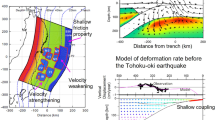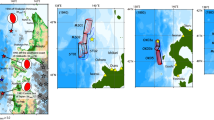Abstract
Intraplate earthquakes are described by a model of a thrust fault in continuous or cracked media. Such a model can also be used to describe interplate earthquakes, in particular, strong earthquakes in subduction zones. However, new seismic, tectonic, and GPS data for this strong Japanese earthquake demand a more detailed model. One possible model can be a model of the elastic island plate coupled with a dipping oceanic plate with submarine mountings. These mountings, sitting on the dipping oceanic plate, hinder its motion due to coupling with asperities on the bottom of the island plate. When coupling ends, the bottom of the plate can be cut as if by a plough and an earthquake can take place. The decoupling of a mountain leads to a weaker interpolate earthquake, a forshock, and an aftershock. The main earthquake is a result of the effect of a basaltic plateau or a large mountain, which leads to the avalanching decoupling of all mountains on a large area of coupled plates. In the first approximation we can consider that, despite its deformation, an oceanic plate is constantly moving with a nearly constant velocity all times both during earthquakes and in between them. An island plate behaves similarly to an elastic plate, which permanently bends due to torque acting on its junction with a dipping oceanic plate. After the earthquake, the bending plate becomes straight. This leads to it thrusting on the oceanic plate with displacement toward the ocean, an uplift of its oceanic part, and the sinking of its island part by the following tsunami.
Similar content being viewed by others
References
Keilis-Borok, V., Gabrielov, A., and Soloviev, A., Geocomplexity and Earthquake Prediction, Encyclopedia of Complexity and Systems Science, Meyers, R., Ed., New York: Springer, 2009, pp. 4178–4194, doi 10.1007/978-0387-30440-3-246
Miura, S., Takahashi, N., Nakanishi, A., Ito, A., Kodaira, S., Tsuru, T., and Kaneda, Y., Seismic Velocity Structure off Miyagi Fore-Arc Region, Japan Trench, Using Ocean Bottom Seismographic Data, Front. Res. Earth Evol., vol. 1, pp. 337–340; JAMSTEC J. Deep Sea Res., 2001, vol. 18, pp. 145–156.
Rogozhin, E.A., The Structure of the 2011 March 11 Tohoku (Japan) Earthquake (M = 9.0), Its Makroseismic, Seismological, and Geodynamic Manifestations, Vopr. Inzh. Seismol., 2011, vol. 38, no. 1, pp. 5–20.
Turcotte, D. and Schubert, G., Geodynamics, New York: John Wiley and Sons, 1982.
Trubitsyn, V.P. and Rykov, V.V., Mechanism of the Formation of Sloping Zones of Subduction, Fiz. Zemli, 1997, no. 6, pp. 1–12.
Trubitsyn, V.P. and Rykov, V.V., A Numerical Model of the Formation of Marginal Seas under the Movement of Eurasia to the Subduction Zone, Split of Japan and Its Possible Future Unification with Eurasia, Vychisl. Seismol., 2001, vol. 32, pp. 248–256.
Trubitsyn, V.P., Geodynamic Model of the Evolution of the Pacific, Fiz. Zemli, 2006, no. 2, pp. 3–25.
Zhao, D., Wang, Z., Umino, N., and Hasegawa, A., Tomographic Imaging Outside a Seismic Network: Application to the Northeast Japan Arc, Bull. Seismol. Soc. Amer., 2007, vol. 97, pp. 1121–1132.
Author information
Authors and Affiliations
Corresponding author
Additional information
Original Russian Text © V.P. Trubitsyn, 2011, published in Geofizicheskie Protsessy i Biosfera, 2011, No. 3, pp. 5–19.
Rights and permissions
About this article
Cite this article
Trubitsyn, V.P. Model of the 2011 Great East Japan earthquake (M = 9.0). Izv. Atmos. Ocean. Phys. 48, 673–682 (2012). https://doi.org/10.1134/S0001433812070109
Published:
Issue Date:
DOI: https://doi.org/10.1134/S0001433812070109




